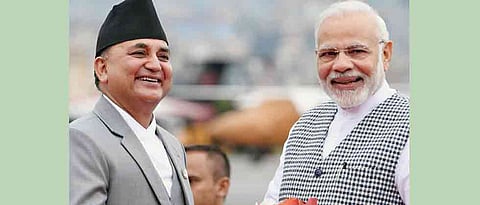

The concept of ‘Love thy neighbour’ is slowly fading in the global scenario. Recent phenomena like the Brexit or the USA withdrawing from the Trans-Pacific Partnership, the global mood reflects resistance towards regional cooperation with emphasis on bolstering national identities.
Given this, for a country like India that lies in the middle of the subcontinent and shares borders with seven counties - China, Pakistan, Afghanistan, Nepal, Bhutan, Myanmar and Bangladesh - it becomes vital to focus on international policies to have a secure and stable neighbourhood that is mutually beneficial - culturally and economically.
But this is hard to achieve when our neighbours are either hostile or semi-peaceful due to increasing illegal migration. One-quarter of the world’s traded goods cross the Bay of Bengal. So why is the trade in the Indian subcontinent missing? South Asia lacks an established organisation such as ASEAN or EU or an agreement like NAFTA built on mutual trust, needs and a promise of cooperation. The trade in the region is minuscule compared to 26% of the total trade within ASEAN, and 58% of the total trade within the European Union.The story is more complex in South Asia. There is great cultural, ethnic and religious diversity in the region and a deeply connected past. But there are also border conflicts, insurgencies, contested identities, and rivalries.
After years of negotiations, BIMSTEC is the only organisation able to withhold the test of geopolitics. A test even SAARC couldn’t pass.
SAARC was founded in 1985 between Bangladesh, Bhutan, India, Maldives, Nepal, Pakistan Sri Lanka and later Afghanistan. Huge summits were held, deals were signed and ambitious promises made that never got kept. 32 years later, SAARC continues to operate without any mandate of significant progress. Its intra-regional trade stands at just 5%. The Uri attack of 2016 forced India to rethink its political and trade relations with Pakistan. Pakistan could not keep the terrorism in check, and hence, India decided to boycott the 2016 SAARC summit held in Islamabad. Afghanistan, Bhutan and Bangladesh joined the boycott and things have been pretty stagnant since. India is building its hopes again with BIMSTEC, especially because it does not include Pakistan.
Founded in 1997, BIMSTEC comprises seven countries in the littoral and adjacent areas of the Bay of Bengal. The organisation was just ‘BIST-EC’ initially (Bangladesh, India, Sri Lanka, and Thailand Economic Cooperation), and later became BIMST-EC when Myanmar joined in December 1997. Nepal and Bhutan entered in February 2004 and the name became ‘Bay of Bengal Initiative for Multi-Sectoral Technical and Economic Cooperation’ (BIMSTEC).
But even BIMSTEC has been struggling to take off since its inception. Thailand and Myanmar pay more attention to ASEAN, while Bangladesh, Nepal, Bhutan, Sri Lanka countries and Afghanistan are waiting for SAARC to revive.
The effort was finally made by PM Modi who promised to revive BIMSTEC as India’s priority organisation. At the SAARC 2014 Kathmandu summit, Modi said opportunities must be realised ‘through SAARC or outside it’. He made sure that after the 2016 BRICS-BIMSTEC outreach summit, BRICS heads of state would reach out not to SAARC but BIMSTEC leaders. Now is the time to capitalise on this bloc that brings together 22 per cent of the world’s population, and has a combined GDP of $3.5 trillion.
Like SAARC, BIMSTEC might become dysfunctional if progress is slow. BIMSTEC has existed for over two decades, but the official secretariat was opened two years back in Dhaka. The Kathmandu summit was only the fourth one. India plans to make up for the gaps.
India needs to take on an informal BIMSTEC leadership role and let its practical commitments lead by example. The most important task is to connect the roads of one nation to another’s. Since 70% per cent movement among BIMSTEC happens via road, better roadways will transform the movement of goods and vehicles through the countries.
The scope is endless as the BIMSTEC Free Trade Area (FTA) negotiations will increase the trade from the current USD 40 billion to USD 240 billion. Talks are ongoing to speed up BIMSTEC’s Coastal Shipping Agreement and Motor Vehicle Agreement as early as possible.
Once achieved, we would have the India-Myanmar-Thailand trilateral highway connecting Moreh in Manipur with Mae Sot in Thailand, and the Kaladan multi-modal transport project connecting Sittwe port in Myanmar with Mizoram, the Kolkata-Birgunj and Kolkata-Kathmandu links, the Dhaka-Chittagong corridor, the Kolkata-Siliguri-Guwahati-Imphal link, and the Kandy-Colombo link. But BIMSTEC still has to shed its ‘SAARC minus one’ image and learn from mistakes. It has already become quite ambitious like SAARC and loaded with 14 sectors to work on. It also lacks the angle of ‘soft connectivity’ between people by allowing to travel freely across borders. BIMSTEC should focus on promoting tourism and cross-border culture with easy visas, customs, and quarantine aspects.
